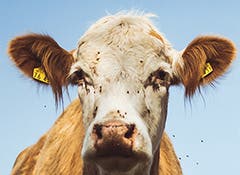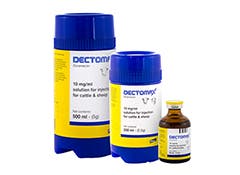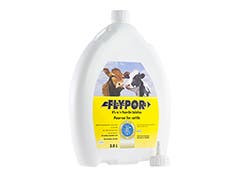Cattle housing
As the seasons move into autumn, most cattle farms look to start housing cattle over the winter months. This is the ideal disease control point where a little thought on which animals to treat for what, with what and when, can have a huge impact on treatment success, animal health and growth rates over the winter.
Controlling ectoparasites during housing
We know that all animals will potentially be at risk from ectoparasites such as lice and mange at housing, so treating all housed animals for these makes sense.
FlyporTM is an insecticidal pour on containing the synthetic pyrethroid (SP) permethrin, for the control of flies, sarcoptic and chorioptic mange, and biting and sucking lice in cattle.
Treating for roundworms at housing
All cattle that have been grazing will have been exposed to roundworms, such as lungworms and gut worms, including type 2 ostertagiasis. On most farms only youngstock (first and second season grazing animals) will be at risk of disease as older animals will have developed immunity to these worms. Adults may then only need a treatment for ectoparasites, eg with FlyporTM, whereas youngstock will need a treatment that covers both worms and ectoparasites eg Dectomax™ Injection for Cattle.
Treating for liver fluke at housing
The decision made at housing for fluke treatment depends on multiple factors, but with fluke having a significant impact on growth rate and time to finishing1 we need to ensure what we do is effective. This means using the right product, at the right time, using the correct dose and administering it in the right way. Unfortunately, no one treatment in isolation will kill all stages of fluke present without consideration of timing of dose.
Why treat animals for fluke at housing
There are two main aims for treating animals for fluke around housing:
- to remove the burden picked up from the pasture during the months before housing, when the pasture levels of infectious stages of fluke are likely to be increasing. By removing this burden when housed, it will help the cattle to perform well over winter and achieve their potential growth and productivity
- to prepare for the following grazing season: by correctly removing these immature fluke they will not develop into egg laying adults and contaminate pasture next year
Treatment options
For best treatment results, the number and age of fluke likely to be present needs to be considered. The NADIS fluke forecast and farm history will help guide this; generally in late summer/autumn, there will be increasing levels of fluke on pasture thus many newly acquired (immature) fluke within the cattle liver.
- At the time of housing:
If infection pressure is high, it may be more beneficial to treat at the time of housing with a triclabendazole drench (eg Fasinex™ 240). Treating now offers convenience of handling at the same time of housing, which minimises handling stress. Triclabendazole drench removes most of the fluke as early as possible. However, any fluke under the age of kill at the time of treatment may survive and go on to affect the cow, meaning the cow will then need a second treatment (ideally with a different active) to remove any remaining fluke. - After the start of housing:
If infection pressure is low, and animals have been grazed on low risk pasture, it may be better to carry out testing to see if treatment is necessary or delay treatment to after the start of housing and use the appropriate flukicide. The benefits of this are that all stages of fluke present in the cattle would be treated by the correct flukicide; however growth rates may suffer initially until treatment is carried out. The flukicide of choice will depend on the timing of treatment:- 2 weeks after housing - triclabendazole drench
- 6-8 weeks after housing - triclabendazole pour on
- 7 weeks after housing - closantel
- 8 weeks after housing - nitroxynil
NB An adulticide fluke treatment - e.g. oxyclozanide or albendazole - would be an inappropriate choice at housing as we expect the majority to be immature or early immature fluke, so an adulticide would be ineffective given at housing and delaying treatment by 10-12 weeks would risk a significant impact on growth rate.
Learn more about liver fluke, and watch our webinar ‘Liver Fluke – Test Don’t Guess’ with Moredun and the NSA on. For more information, check the updates from COWS.

Managing worms in cattle
Worm burdens can cause productivity losses and affect growth rates in youngstock.

Liver fluke in cattle
Find out why liver fluke in cattle is a growing threat, management strategies and treatment options.

Ectoparasites in cattle
Nuisance flies, mange mites and lice cause irritation, stress and productivity losses.
- Mazeri et al, Nature Scientific Reports, 7: 7319, 2017


